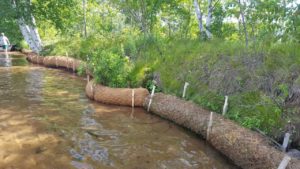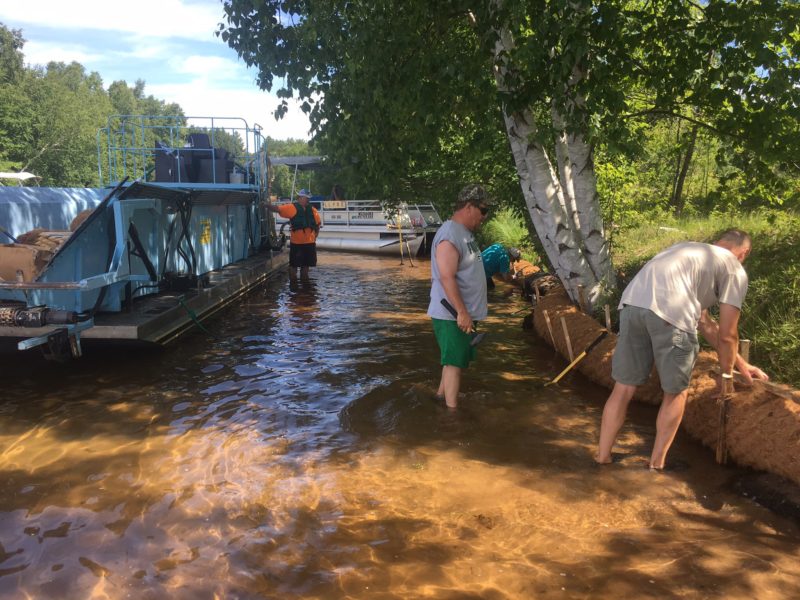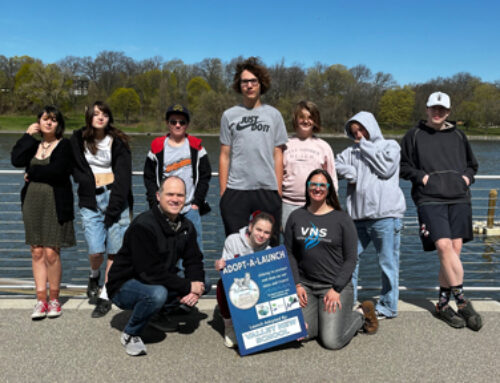What is a Bio Log?
Bio Logs are rolls of organic material such as coir (fibers from the outer husk of a coconut), or different types of wattle (fabricated poles with interwoven strands of rice, straw, or wheat). These organic materials of the bio logs are tightly packed and cause them to have a varying, thick, diameter. The purpose of a bio log is to help prevent erosion of banks and slopes along shorelines while also promoting vegetative growth. It does so by creating a barrier or obstacle that causes water that would normally run-off along the surface, to pool and allow for sediment to settle rather than be washed away and into the surrounding water body. The organic material then provides a favorable growing environment for different kinds of plants and can promote establishment in that area. The root systems of established plants will tightly hold the shoreline sediment in place making it more stable and less susceptible to erosion.

(Pictured left) Several bio logs placed around the shoreline of Horseshoe Island. They will not only help reduce erosion, but protect against shoreline bumping caused by boats that may be rammed into the shoreline as well as logs and other floating materials that may wash up. (Photo Credit: Jeremy Johnson)
History of Horseshoe Island
Horseshoe Island is located in the Sapokesek basin on the eastern end of Legend Lake. The Island is owned by the town of Menominee and is designated by the DNR as a sensitive area. According to Jeremy Johnson, the department director of conservation, zoning, and forestry in Menominee County, Horseshoe Island has been experiencing some real problems with erosion in past years. Johnson states “Horseshoe Island is eroding away at a rate of several feet per year.” In fact, over the past few decades, the shoreline has eroded by 50-100 feet. The island is surrounded by a sandy bottom which provides a great social area for swimming and recreation causing it to be heavily trafficked by boaters around the lake. The problems arise when boaters tie their boats up to trees or anchor them into the shoreline
as this causes increased bumping and degradation ultimately leading to a greater susceptibility of erosion. Johnson states, “…the island is a great gathering place to socialize, but we need to protect it for future users and for the protected cove it provides for wildlife habitat.”
Looking forward to success
Moving forward with the project, the town of Menominee has high hopes that people will recognize the biologs project and be reminded that we need to conserve the resources we value. In the grand scheme of things, the biologs should help to impede the erosion of Horseshoe Island. In turn, this can create opportunities for restoration projects in order to make an already enjoyable landmark, even better.
As boaters there are several things one can do to aid in this project. Firstly, do not anchor or tie up to trees along the shoreline. There are various anchors such as a Danforth that you can use to holdfast your watercraft to the sandy bottom. Secondly, be courteous and aware of the biologs. The less they are tampered with, the more optimal they are going to function for their purpose. Finally, do your part as a citizen to make the location enjoyable for everyone, though it is not what is once was, Horseshoe Island is still a beloved landmark that is consistently enjoyed by those who use the lake. This includes, clean up of garbage, respect to other boaters regarding low wakes, space, etc, or even just a simple acknowledgment or conversation. As with all environmental projects, a group effort goes a long way!
For additional information or any questions, contact us @:
Website: Fwwa.org
Email: Brady@fwwa.org
Phone: 920-851-4336








